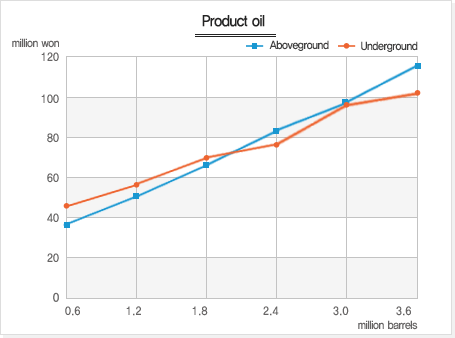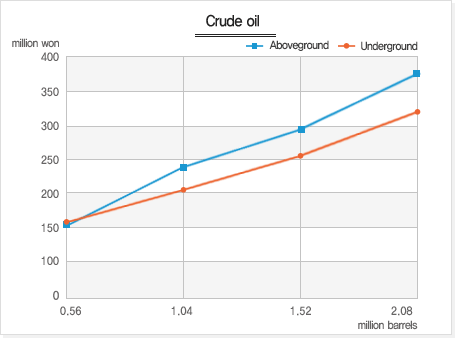|
 |
Pros and cons of aboveground and underground storage |
|
| |
| |
Aboveground |
Underground |
| Pros |
Short construction time (3~5 years) Easier construction |
Can be used semi-permanently Construction and maintenance costs are lower Environmentally friendly (minimal harm to the environment) |
| Cons |
Safety vulnerability to outside attack and fire High construction and maintenance costs Short facility lifespan (15) |
Lengthy construction period (5~8 years) |
|
| |
 |
Review of economic costs/benefits for aboveground and underground storage bases |
|
 |
| |
| Although it may vary depending on the site and material conditions, in general, aboveground storage facilities are advantageous for storing less than 2.4 million barrels, while underground storage facilities are advantageous for storing more than this amount. |
| |
 |
| |
| Although it may vary depending on the site and material conditions, in general, aboveground storage facilities are advantageous for storing less than 5.6 million barrels, while underground storage facilities are advantageous for storing more than this amount. |
| |
No significant differences were found upon review of construction expenses for the third project as well as maintenance and management expenses for operating facilities as a result of assessing cost per barrel on the basis of construction costs. However, if one considers the maintenance and management expenses and lifespan of the contents of facilities (i.e. 40 years for underground facilities and 20 for aboveground facilities), the underground storage facilities are significantly more advantageous (with cost savings of approximately 50%).
In particular, aboveground tanks have rapidly increasing maintenance expenses with the passage of time, and a high natural rate of attrition for stored oil. The emission of VOCs in particular makes them environmentally undesirable. For large-scale storage of crude oil, underground storage is absolutely more advantageous. |
|
Department Contacts Updated
| |
Department : Stock Engineering & Construction Dept. |
Contacts : +82)52-216-5304 |
|